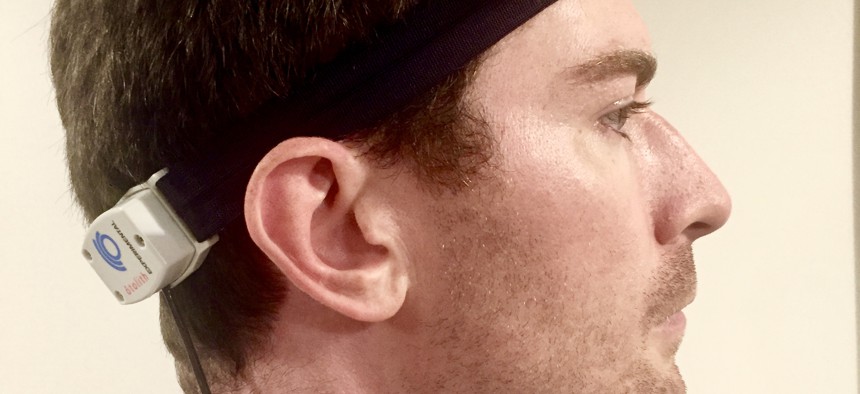
Inventor Sam Owen shows of the OtoTech, a device that prevents motion sickness by sending subtle vibrations through the inner ear to the brain. Sam Owen
This Inventor May Have Cured Motion Sickness Without Drugs. And That Could Mean a Lot to the US Military
One manufacturer of virtual-reality trainers has already begun including the devices in its simulators.
An inventor may have discovered a non-pharmaceutical cure for car sickness that could revolutionize the way people experience everything from travel to the newest virtual-reality headsets. That, in turn, could affect how the military trains, fights, and navigates.
Just like civilians, troops get motion-sick. A 2009 study by the Naval Aerospace Medical Research Laboratory found that more than half of soldiers got sick while riding in Army vehicles. Roughly 25 percent of military personnel got sick on “moderate seas” and 70 percent on “rough seas.” In the air, as many as 50 percent of personnel get airsick; even 64 percent of parachutists reported episodes.
To treat symptoms, troops typically take a drug called scopolamine. It has serious side effects, most notably drowsiness, so soldiers often take it with an amphetamine that carries its own downsides and side effects. It’s like being on uppers and downers at once, which makes for a fatiguing Friday night, much less a war.
The military’s problems with motion sickness will worsen considerably as more and more training is conducted in virtual reality.
Related: DARPA-Funded Work May Help Troops See Around Corners
Related: SpaceX: We’ll Consider Launching Space Weapons If Asked
Related: Retired Marine Four-Star Patents Jet-Killing Drone Boat
“The availability of immersive learning environments like virtual-augmented-mixed reality afforded by commercial off-the-shelf technology fosters has the potential to create the paradigm shift necessary to deliver the most ready force ever known,” said Lt. Col. Matthew Strohmeyer, the 560th Flying Training Squadron commander. Yet VR training, in particular, can make troops sick. “Though we have made great strides in understanding the true causes of air sickness, from a cellular physiology perspective, much is still to be learned, especially when it comes to cyber sickness.”
The Air Force Research Lab is currently looking at the effects of motion sickness among a small group of “future instructor pilots” that are training with a new syllabus that uses virtual reality. The research brings in experts from the South Dakota School of Mines and Technology as well as physiologists and small businesses. “Our findings will further inform safety countermeasures to ensure aviators can meet the demand of any physiological threat that presents itself,” said Strohmeyer.
The Air Force isn’t just looking to use VR for pilots. They’ve contracted with a Portland, Oregon-based company called VR Motion to train truck drivers. “What we’ve learned is that the current method for training hasn’t been updated for decades,” said Keith Maher, the company’s founder and CEO. “Driving a large combat vehicle like a Humvee, or an up-armored Humvee on public roads, is actually counter to what they [the Humvees] are designed to do. On public roads, there will be pedestrians and small vehicles. The large blind spots that you have in a Humvee are something you need to train for...With our virtual reality technology we can recreate high-hazard situations whenever we want.”
But as many gamers are today discovering, VR can have big motion-sickness effects.
“Historically, we’ve seen about a 20 to 30 percent discomfort level” with VR training, Maher said. “That’s a big number for us if we want our product to go out and change the lives of millions of people.”
Enter a young inventor named Samuel Owen, who has developed a prototype device called the OtoTech, from Otolith Labs. Worn on a headband behind the ear, it uses subtle vibrations to change the way the brain computes the fact that the body that it’s attached to is in motion. Early tests show it relieves motion sickness without the side effects of drugs, Owen said, though he admits the science is so young that it’s not clear just how.
The vibrations emanating from the OtoTech gently target two of the four fibers that carry data about body motion to the brain via a system of inner ear sensors called the vestibulocochlear nerve. “Two [of the four vestibulocochlear nerve fibers] go to the brain, two go to your reflexes,” Owen said. The trick is to affect the former and not the latter.
“The working hypothesis is that [the vibration] causes a chaotic and noninformative stimulus to go to the brain. Somewhere, probably the cerebellum, there’s a filtering mechanism that filters out noninformative sensed information. It’s the reason you don’t notice the shirt on your back right now,” he said.
In other words, while you remain consciously aware that you’re moving, the balance portion of your brain stops noticing the fact; the data has been drowned out in white noise from the device.
So far, he says, initial testing shows that it works to prevent motion sickness without affecting balance, vision, alertness, or anything else it’s not supposed to.
Researchers at Jaguar Land Rover are conducting double-blind trials with the device, moving toward publication, he says. Medical researchers at Coventry University in the U.K. and the University of Miami are looking at therapeutic applications related to treating vertigo.
Owen says that he has initially marketed the device to vertigo sufferers, and not yet to the military, or even the motion-sickness market. But Maher has begun to incorporate Owen’s device into his VR trainers.
“We noticed that it would improve the overall virtual reality experience,” said Maher. “We’ve started to use it in our military devices. The initial reaction is, it looks unusual, but afterwards, people don’t event notice.”
Related podcast:




